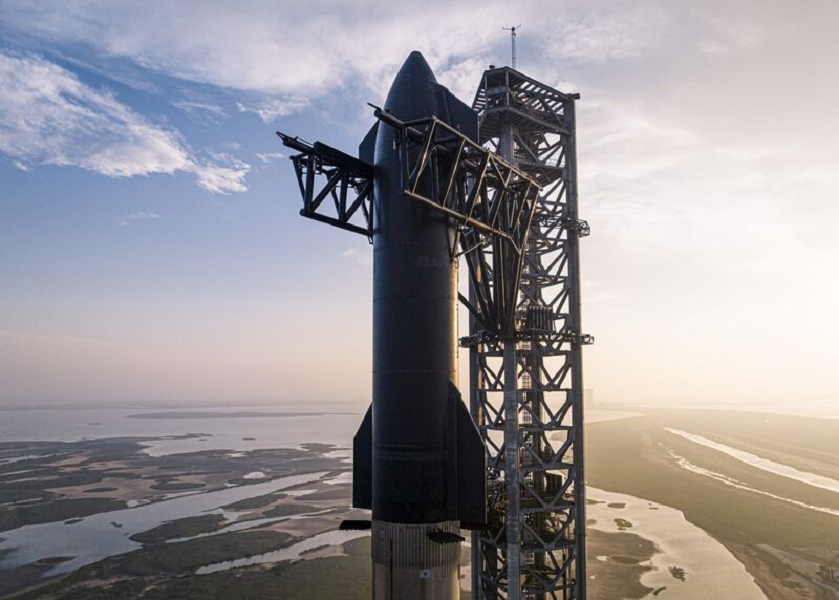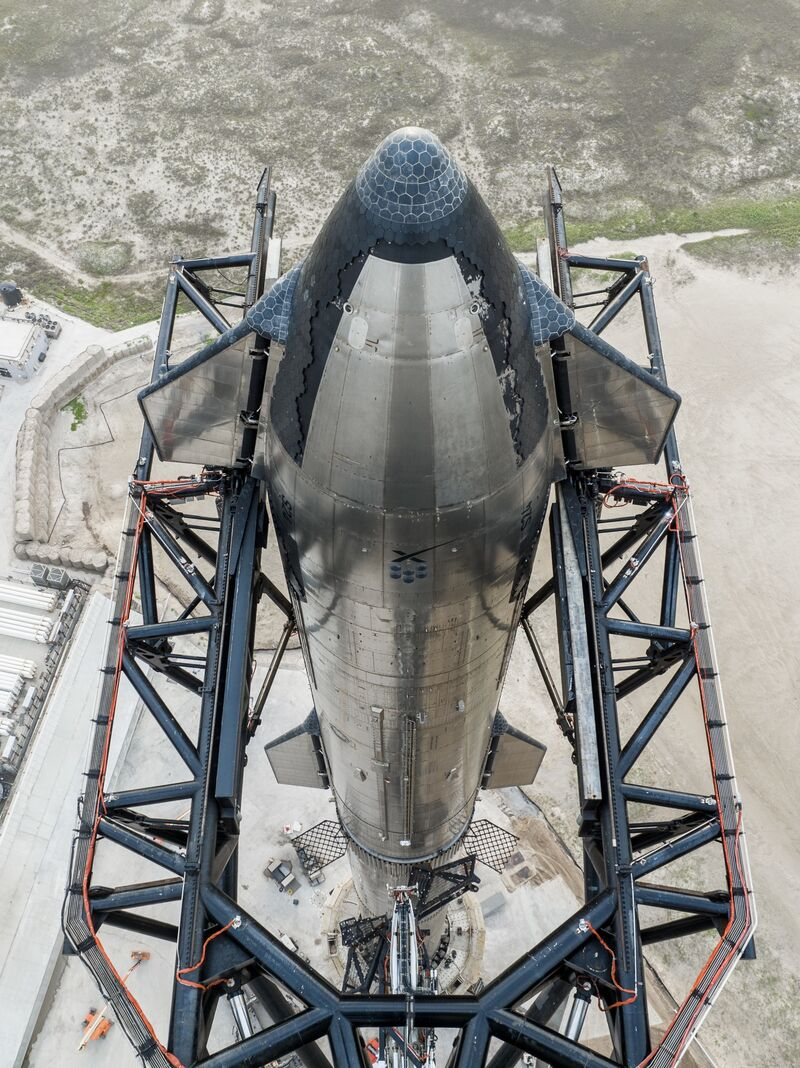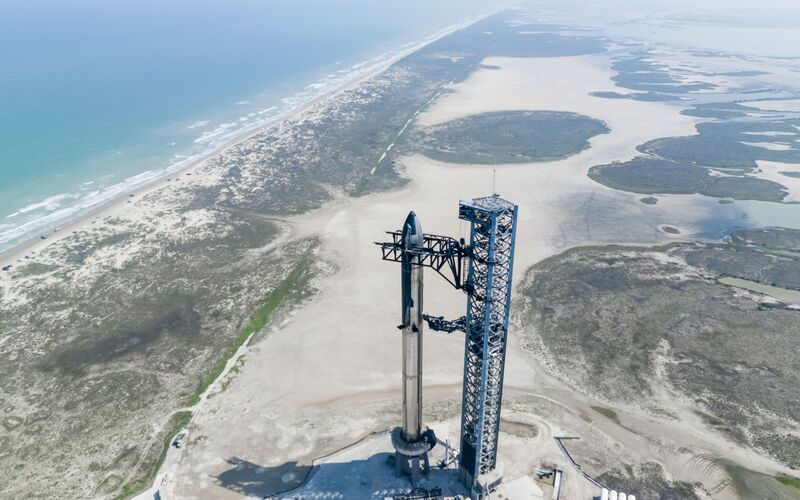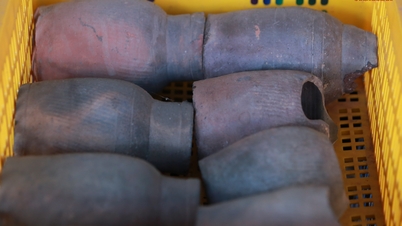This test launch has been in the works for nearly two decades. Elon Musk has been hinting at plans to build a giant rocket called the “BFR” since 2015.
While the details of the plans surrounding this rocket have changed over time, its overall goal has remained the same: to take humanity to other planets and fulfill Elon Musk's dream of colonizing Mars.
“Starship is the first vehicle that can deliver on Musk’s multi-planetary vision,” said Caleb Henry, research director at Quilty Analytics, a space consultancy. “So it’s like everything has been leading up to this point.”

The completed Starship rocket will become the most powerful rocket ever built in human history to date. Photo: SpaceX.
Once completed, the Starship will be the most powerful rocket ever built, capable of delivering 16.7 million pounds of thrust at liftoff and delivering a huge payload into Earth orbit or beyond. That power and size makes the rocket a key part of SpaceX’s future, as it will be able to launch large satellites and crewed missions into space. NASA plans to use the rocket as part of its lunar return strategy, after the agency signed a $2.9 billion contract with SpaceX to help it return to the moon. The Starship is also designed to be fully reusable, unlike any other rocket ever built. SpaceX says this will help reduce the cost of operating the rocket.
All of which makes Monday’s test incredibly important. Before these grand dreams can become reality, SpaceX must prove that Starship can work.
“We need to launch and control this rocket to understand it better,” SpaceX chief Gwynne Shotwell told reporters in February at a space industry conference.
Starship rocket system
At 120 meters (394 feet) long, the Starship rocket is a giant space rocket, larger than the Saturn V rocket used to send astronauts to the moon in the 1960s and 1970s, and larger than NASA's Space Launch System rocket, which was first tested in November 2022. The Starship rocket will also be the most powerful space rocket in history, capable of carrying 150 to 250 tons of cargo into Earth orbit. The most powerful rocket SpaceX currently operates, the Falcon Heavy, is only capable of carrying 64 tons of cargo into orbit. Starship will allow for larger payloads to be carried into space, such as SpaceX's new, larger Starlink satellites. Elon Musk also said that this space rocket will be able to serve up to 100 passengers at a time.

The Starship rocket is larger than the Saturn V rocket. Photo: SpaceX.
The Starship space rocket system consists of two parts: a giant rocket booster and a spacecraft carrying cargo and people.
The Super Heavy booster is a large tube rocket that sits at the bottom of the entire system when assembled on the launch pad. At liftoff, SpaceX’s 33 Raptor methane-powered engines are designed to ignite simultaneously, creating the massive thrust needed to send a large payload into the Earth’s atmosphere.
The bullet-shaped Starship sits atop the Super Heavy rocket. Its multi-purpose nature sets it apart from any other space vehicle to date. It can be a manned spacecraft, a manned lander, a propellant carrier, and a satellite delivery vehicle.
Both parts of the spacecraft—Super Heavy and Starship—are designed to return to Earth and land intact. However, the landing technique is a bit unusual: two robotic arms will extend from the launch pad where the rocket took off, and “catch” the rocket before it hits the ground.
This is an incredibly complex system, much of which has never been tested.
“This is really a test launch,” Shotwell told reporters. “And the goal is not to blow up the pad. That alone would be a success.”

SpaceX Starship rocket in Boca Chica, Texas. Photo: SpaceX.
Test launch
The Starship rocket will not carry cargo or passengers on this first test launch.
On Monday, starting at 7 a.m. ET, SpaceX will attempt to launch the Starship rocket from the company's Starbase facility in Boca Chica, Texas, where the company has been mass-producing Starship rocket prototypes for the past five years.
Less than three minutes after liftoff, the Super Heavy booster will separate from the Starship and fall toward Earth in a controlled landing in the Gulf of Mexico. There, the booster will sink to the ocean floor and there are currently no plans to retrieve it. Tests of the booster’s reusability will be conducted during future test launches.
Once separated from Super Heavy, the Starship will fire its own engines, launching the Starship deeper into space and bringing it close to orbital speed. About nine and a half minutes after liftoff, the Starship’s engines will shut down, and the spacecraft will begin its orbital flight, reaching a maximum altitude of about 146 miles (234 kilometers).
The Starship won't make a full orbit around the Earth. About 140 miles off the coast of Hawaii, it will re-enter Earth's atmosphere and fall into the Pacific Ocean.
This patchwork test was intended to demonstrate a few goals: that Starship and Super Heavy could separate as intended, and that once separated, Starship could reach orbital velocity and then return to Earth.
Journey to Starship
This test will be the most complex and important test of Starship. SpaceX conducted a series of high-altitude test flights in late 2020 and spring 2021, taking Starship prototypes to 32,800 feet (about 10 kilometers) and attempting to land them on Earth. Only one prototype in this series landed intact without exploding. This will be the first test launch of the Super Heavy rocket.
Since SpaceX began developing Starship in 2018, the test launch has been a visible goal, and the company has consistently made progress toward Elon Musk’s desired launch date. The company has also been waiting for the Federal Aviation Administration (FAA) to conduct a review of Starbase to determine the environmental impacts of the new expansion. In June 2022, the agency said SpaceX needed to incorporate 75 mitigation measures to reduce the facility’s impact on the surrounding area. Finally, on April 14, the FAA gave SpaceX the green light to launch Starship from Boca Chica.
Once licensed, SpaceX can launch Starship whenever it wants. And they’ll need to do it quickly, because SpaceX has a series of important flights planned for Starship — from taking NASA astronauts and tourists into space to delivering cargo and satellites.
“I would love to be able to launch Starship 100 times next year,” Shotwell said in February. “I don’t think we’ll be able to launch Starship 100 times next year, but maybe by 2025 we’ll be able to launch 100 times.”
Nguyen Quang Minh (according to Bloomberg)
Source

























![[Photo] The 9th Congress of the Party Committee of the Office of the President, term 2025-2030](https://vphoto.vietnam.vn/thumb/1200x675/vietnam/resource/IMAGE/2025/6/20/78e7f27e8c4b4edc8859f09572409ad3)



























![[Maritime News] Wan Hai Lines invests $150 million to buy 48,000 containers](https://vphoto.vietnam.vn/thumb/402x226/vietnam/resource/IMAGE/2025/6/20/c945a62aff624b4bb5c25e67e9bcc1cb)













































Comment (0)